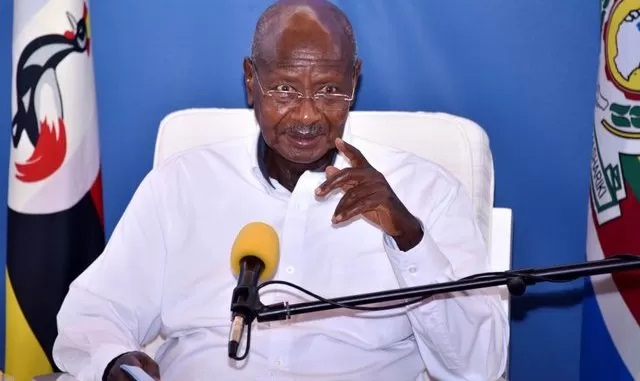By Spy Uganda
President Yoweri Museveni has told Ugandans that it is very possible to fight poverty if they get involved in lucrative commercial agriculture such as dairy farming and the four (4) acre-model farm strategy.
According to the President, in December 1966, they (the student group) launched an anti-nomadism campaign in Kiruhura and they moved from kraal to kraal educating people, about the dangers of nomadism and the pre-capitalist traditional economy of only working for the stomach (okukorera enda yoonka).
“Many people listened to our message and stopped nomadism, fenced the land they occupied traditionally, dug bigger wells, started spraying against the ticks, stopped bush-burning and engaged in crop farming (especially bananas), in addition to cattle rearing. The calf mortality was radically reduced, and their herds multiplied. Between 1966 and 1986, their herds multiplied and had more food security but then, one question remained unanswered. This is the issue of the correct enterprise in terms of maximizing homestead incomes, taking into account the size of the family land,” says Museveni.
“On account of lack of education, the wanainchi would copy blindly. So and so is rich with several herds of Ankole cattle ─ let us say 1000 ─ I must be rich like him. In other words, I must be a rancher. However, to have 1000 cattle, you need 3½ square miles of land, if you are still using the free-range method (kuseetura).
Yes, with 1000 Ankole cattle, you can sell about 200 per year for beef and this gives you more than Shs.200 million in today’s money. That is not bad. The problem, however, was that many people did not have 3½ sq. miles of land and could, therefore, not be ranchers with the free-range model (kuseetura). That is how, in 1989, after careful analysis, I recommended dairy farming to them.”
In order to get quick economic gains from dairy farming, Museveni advised that the small and medium holders should go for Friesian cattle.
“What have been the results? Big transformation. Milk produced in Uganda has gone from 200 million litres per year to now 3.22billion per year and Uganda’s processing companies have increased from just 01 company (DCL) with a processing capacity of 60,000 litres per day in 1986, to currently 145 companies with a processing capacity of 2.89 million litres per day. These are employing mainly women and youth,” he boasted.
The President further disclosed that Uganda’s dairy sector is now valued at US$ 3.8 billion, the export portion of which brings in US$ 106.2 million per year.
“We are aiming at 20 billion litres. You will not get out of poverty through ranching but you could get out of poverty through dairy farming,” President Museveni said, adding, “I am, therefore, very happy that you, the women of Uganda, are here to witness this transformation I have been telling you about. The whole of the cattle corridor has got this message and have embraced it. Parts of the districts involved are found in Isingiro, Kashaari, Kiruhura, Kazo, parts of Ibaanda, Lyantonde, parts of Rakai, Ssembabule, Kyegyegwa, parts of Gomba, parts of Mubende, Kiboga, Kyenkwaanzi, Nakaseke and Nakasongola.”
After fighting the successful war against nomadism in 1995, Gen. Museveni asserted that he then embarked on a country-wide tour lecturing Ugandans about the four (4) acre-model strategy aimed at fighting poverty and improving household incomes.
The four acre-model entails putting coffee on one acre, fruits on the second acre, pasture for zero grazing Friesian cattle on one acre and food crops on one acre (bananas, cassava, etc). In the backyard, those interested could put poultry, a piggery and those near water would do fish farming.
“These are activities that have got a huge global market that we have long ago confirmed and have a good return per acre, per annum. With these, we cannot go wrong,” the President remarked.
“The four-acre model is part of what we call intensive agriculture. It is designed to benefit the country but particularly to benefit the smallholder. There are other products that the country needs, but do not fit in intensive agriculture. They come in what is called extensive agriculture ─ getting a small income per acre but doing it on a big scale. This is where maize, sugar cane, cotton, ranching, and tobacco, etc., etc., come in. While the Parish Development Model (PDM) deals with the 4-acre model, Uganda Development Bank (UDB), will handle the extensive agriculture.”
President Museveni also explained that when families get out of poverty through commercial farming, manufacturing, services, and ICT ─ the four sectors ─ it is easier to address all the other marginalized groups including women.
“Will wealthier families pay for the girl child to study or not? Show me a daughter or son of a rich family that has dropped out of school on account of not being able to pay the school costs. Families getting out of poverty is a good base for solving other problems. Yes, you may get greedy men who get “rich” and abandon their wives and children. The question is: “Are they really rich?” “Or are they just having some little money while previously, they had nothing?” Otherwise, if the families are rich, the courts of the State can even discipline irresponsible husbands to share the wealth with their spouses. How will the courts force a poor husband to share poverty with his poor wife and children? Families getting out of poverty is a good first step,” he said.
He also appealed to the people of the cattle corridor to stop fragmenting wealth when the head of the family dies, advising them to instead share by emigabo (shares), not physical fragmentation.
“Therefore, all Ugandans, stop excuses. It is possible to get out of poverty. The people in the cattle corridor had gotten out of poverty through the dairy industry guided by the NRM. They are now sliding back because of the residual cultural backwardness. We are also fighting that. You all can get out of poverty.”







